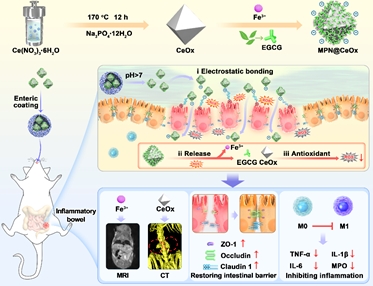Inflammatory bowel disease (IBD) is a chronic non-specific inflammation of the gastrointestinal tract. The prevalence of IBD continues to grow rapidly in China. Exploring new diagnosis and treatment technologies and methods for IBD will provide effective basis for comprehensive prevention and treatment of IBD, which possesses huge social need.
Currently, small-molecule drugs and antibiotics are the clinical options for treating ulcerative colitis (UC), but these strategies do not completely cure UC due to lack of specificity, and a further increase in drug doses can lead to serious side effects. Meanwhile, the clinical diagnosis of UC is mainly achieved by endoscopy, which is invasive and unfriendly to most patients. Therefore, it is a pressing need to develop multifunctional nanomedicines to achieve image-guided treatment of UC.
Li Runqing, Assistant Researcher from Department of Radiology of the First Affiliated Hospital (FAH) of Xi’an Jiaotong University (XJTU), joined hands with Zhang Mingzhen’s team from Institute of Engineering Medicine of XJTU, and experts from Department of Gastroenterology of the First Affiliated Hospital (FAH) of Xi'an Medical College to tackle this issues. The team developed a delivery nanosystem based on metal polyphenol network/cerium oxide artificial enzymes (MPN@CeOx) to manage UC and evaluate the severity of inflammation by MRI/CT imaging. MPN@CeOx was engineered by Fe3+ and epigallocatechin gallate (EGCG) wrapped around CeOx. Increased levels of oxidative stress in the inflammatory lesion facilitated the release of Fe3+ and EGCG from MPN and liberated CeOx. EGCG with anti-oxidative and anti-inflammatory effects plus CeOx with superoxide dismutase (SOD)-like activity effectively scavenged reactive oxygen species (ROS) and reduced pro-inflammatory cytokines to protect cells from oxidative damage. In addition, H2O2-responsive releasing of Fe3+ at the site of inflammation and Ce elements in CeOx enable MRI/CT imaging of UC. In mice colitis models, oral administration of enteric-coated MPN@CeOx alleviated intestinal inflammation and intestinal barrier dysfunction. RNA sequencing analysis revealed that MPN@CeOx ameliorated UC symptoms mainly through inflammation-related signaling pathways. MPN@CeOx with multilevel inflammation management and multimodal imaging capabilities represents an innovative diagnosis and treatment approach for UC.

These findings were published as an Article entitled "Metal polyphenol network/cerium oxide artificial enzymes therapeutic nanoplatform for MRI/CT-aided intestinal inflammation management" in Nano Today, an international authoritative journal in this field (IF:17.4). Doctoral student Deng Zhichao from School of Basic Medical Sciences of XJTU is the first author. Zhang Mingxin, Director of Department of Gastroenterology of the FAH of Xi'an Medical College, Assistant Researcher Li Runqing, and Zhang Mingzhen, dual-appointed professor from Department of Hepatobiliary Surgery are the co-corresponding authors. XJTU is the first and corresponding affiliation of this article.
Article link: https://www.sciencedirect.com/science/article/abs/pii/S1748013223002931?dgcid=author
